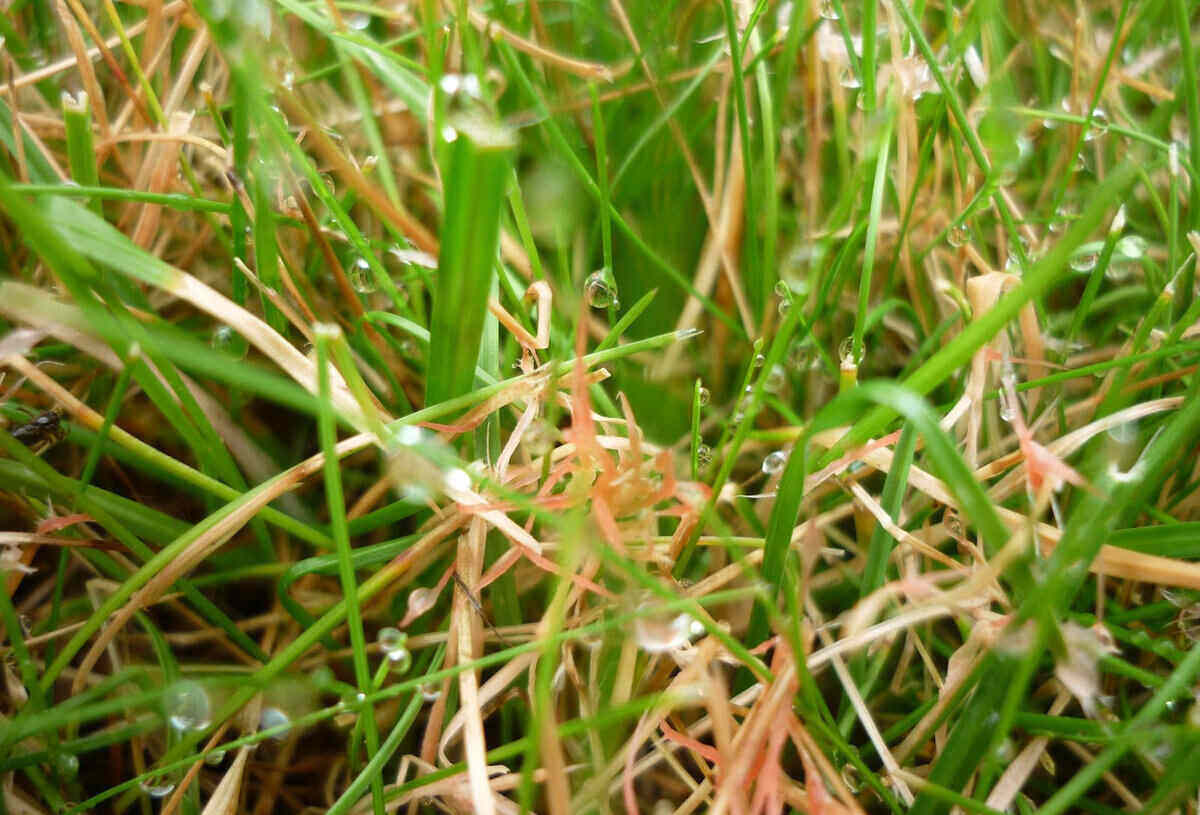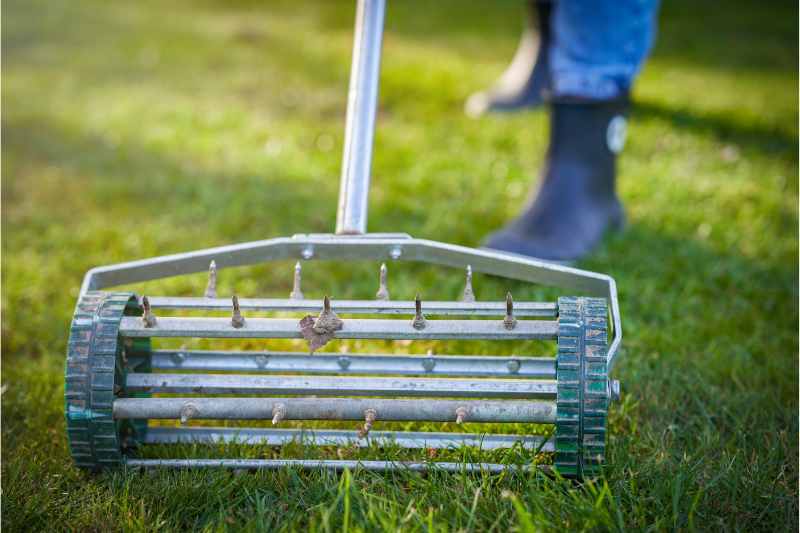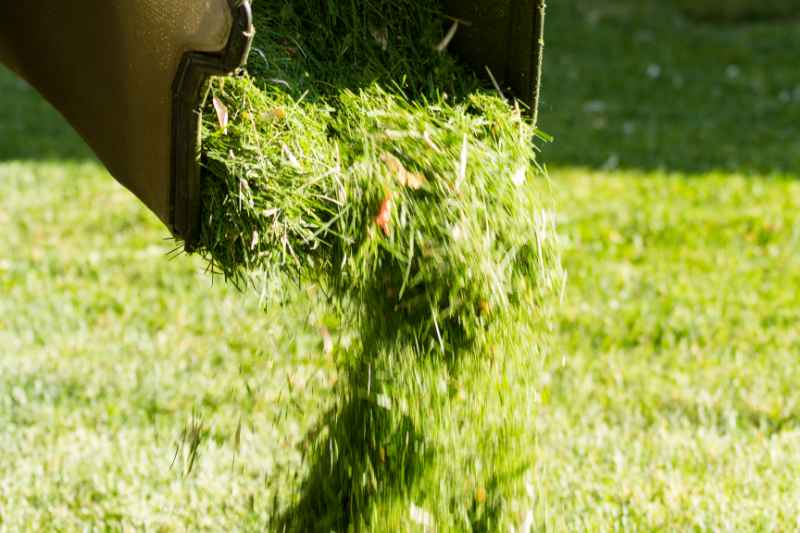
If your grass looks like it’s covered in pink silly string–and you didn’t just throw a party–then your lawn may have red thread disease. But before you go on a fungicide frenzy, it’s important to learn what red thread is and how to get rid of it. You might be surprised to learn that fungicides aren’t the best treatment for this turfgrass disease.
What is red thread?
Red thread is a fungal lawn disease caused by the corticioid fungus Laetisaria fuciformis. It has two stages. In the first stage, red, thin needle-like strands extend from the grass blade. These strands are called stromata, and they infect the grass blade after germinating. Stromata can remain active in the soil for up to two years. In the second stage, pink, fuzzy, web-like mycelium develops where grass blades meet. This stage occurs during wet and humid conditions.
How to identify red thread
From a distance, red thread symptoms appear as pink or tan circular patches 1 inch to 2 feet in diameter. You may notice the patches contain a mix of healthy green grass and diseased grass that’s tan or white.
The turfgrass disease resembles similar symptoms to pink snow mold, dollar spot, and pink patch disease. But you can easily distinguish red thread by the pinkish-red, antler-like threads that protrude from the tips of infected grass blades.
How to get rid of red thread
To get rid of red thread in your lawn, you need to correct your lawn care practices and speed up your lawn’s growth. If you don’t prioritize lawn care maintenance, the disease is more likely to return. The following treatments will help restore your healthy lawn and get rid of red thread:
Aerate your soil

Over time your lawn’s soil becomes compacted due to foot traffic and harsh weather, cutting off access to oxygen and nutrients. Regularly aerating the soil not only enhances growth but also improves drainage, making your lawn less inhabitable to red thread and other fungi.
Annual aeration will keep the soil loose and porous for optimal plant growth. There are two methods of aeration:
- Spike aeration pokes holes into the ground with solid tines or a pitchfork to alleviate compaction.
- Core aeration, also known as plug aeration, removes a core or plug of grass and dirt. For larger lawns, you can use a gas-powered aerator or a manual core aerator which has a handle, a foot bar, and several hollow tines attached.
Apply fungicides

Chemical fungicides that contain the active ingredients azoxystrobin, penthiopyrad, polyoxin D, and propiconazole will control red thread, but there are things you should keep in mind.
Fungicides can be expensive and must be applied continuously, otherwise, the red thread will return. To manage red thread with fungicides, you should apply the product before the disease appears. Some fungicides can be used after the disease has appeared, but they’re less effective.
Treating red thread with chemicals is not recommended for residential lawns. Chemical control should be a last resort since taking care of your lawn is a much more effective way to treat and prevent the disease. Some research indicates that fungicides can upset the balance between pathogenic and antagonistic microorganisms and enhance the severity of other diseases.
Bag your clippings

Collect grass clippings after each mow to decrease the number of fungal threads so that they aren’t reintroduced into the soil, and the disease doesn’t spread. Put the clippings from affected areas into a bag, and throw them in a dumpster.
Make sure to thoroughly wash your mowing equipment between uses. Turn off the mower, take out the spark plug, and make sure that you’ve used up the oil and fuel before you powerwash your mower deck with a hose. If there are any stubborn grass clumps, scrub them off with a brush.
Dethatch your lawn

Thatch is a layer of undigested roots, leaves, and organic plant material that sits between your turfgrass and the surface of the soil. Thatch not only blocks air, water, and fertilizers from reaching your grass, but it also creates the perfect home for fungal diseases like red thread.
Removing thatch by aerating your lawn is the best way to help manage the disease. Other methods of dethatching include manually raking your lawn or, for larger yards, using a dethatcher or a scarifier to cut up and loosen the soil.
Fertilize your grass

Fertilizer can keep your grass healthy enough that it can outgrow red thread and make living conditions less than ideal for the disease. However, keep in mind that fertilizing too much can have the opposite effect and contribute to the spread of the disease.
A way to ensure that this doesn’t happen is to use a recommended amount of slow-release fertilizer regularly throughout the season. You can also spread a light application of quick-release nitrogen fertilizer. Applying nitrogen in the fall will nourish your recovered grass in the spring without overfertilizing it.
It can take a couple of weeks for the turf to recover after the red thread disease is no longer active, and it may take up to two years of fertilizing regularly to prevent red thread fungus from coming back.
Limit foot traffic

To get rid of red thread, you will need to minimize heavy traffic on your lawn so that your grass isn’t stressed by constant damage and repair cycles. A helpful way to do this is to install walkways and patios to reroute traffic or widen your walking paths.
A few other landscaping ideas you can try are:
- Rope barriers
- Fencing
- Hedgerows
- Motion sensor sprinklers
- Paved footpaths
- Gravel
- Mulch
Maintain soil pH

Managing your lawn’s pH levels is also an important element in getting rid of and preventing red thread. Not having the proper amount of nutrients can contribute to the severity of not only red thread but other lawn diseases.
To determine if your soil has the proper amount of nutrients, you can purchase a soil test and send samples of your soil to a lab.
To prevent red thread, your soil should maintain a pH between 6.5 and 7. If it is too low, you can apply lime to your lawn so that it’s more alkaline and less acidic. If you need to increase your pH, then you should apply elemental sulfur, aluminum sulfate, or sulfuric acid.
Mow your lawn regularly

Poor mowing habits can put stress on your lawn. Mow your lawn correctly and regularly to combat and prevent red thread and other lawn diseases.
Compacted soil and thatch are where red thread likes to make its home, so keep that in mind when mowing. Make sure that you mow your lawn when the grass is dry so that the cut is clean and there’s less risk of compacting the soil. Alternating your mowing pattern can also decrease the risk of soil compaction.
Pro tip: Remember the one-third rule. This rule states that you should never remove more than one-third of the grass blade per mow so as not to stress your grass.
Overseed the lawn

If your grass is a variety that is particularly vulnerable to red thread, then you may want to consider overseeding your lawn with grass cultivars that are resistant to the disease. Overseeding is a routine part of lawn maintenance that is simply planting new seeds on top of your existing lawn. This will keep your lawn thick and healthy year-round.
Grass varieties that are resistant to red thread are warm-season grasses. These include:
- Bahiagrass
- Bermudagrass
- Buffalograss
- Carpetgrass
- Centipedegrass
- St. Augustinegrass
- Zoysiagrass
Pro tip: Even just overseeding your lawn with the grass you already have is beneficial since it will help revitalize your grass and improve your lawn’s ability to resist infection.
Trim and prune your trees

Another method of creating an inhospitable environment for red thread is to increase sunlight and air movement. You can do this by pruning and trimming your trees and shrubs so that there’s more sunlight shining on your lawn.
You can even go as far as to remove any trees that are blocking the sunlight your grass needs for nutrients. Most plants are fed through a process called photosynthesis. This process uses sunlight to synthesize nourishment from air and water.
If they don’t get enough sunlight, they don’t get enough food, and this can leave your grass weak and stressed, making it vulnerable to diseases like red thread.
Water properly

Watering your grass at the right time of day helps avoid prolonged periods of grass wetness that cultivate fungus. If you water too much for short periods, you will weaken your lawn’s root system. Instead, you should water less frequently but for longer periods to promote a strong root system.
Water in the early morning before 10 a.m. so that your lawn has enough time to absorb water before the afternoon sun evaporates the moisture. Avoid watering at night otherwise, you will create a moist environment that encourages pests and disease.
What causes red thread?
Many factors can make your yard an attractive host for red thread’s causal agent, Laetisaria fuciformis. Slow-growing and nutrientless turfgrass is more susceptible to red thread disease.
Infected grass spreads the fungal disease pathogen in many ways, including through water, wind, and contaminated lawn equipment (mowers, trimmers, etc.).
If red thread is appearing on your lawn, here are some environmental conditions that could be contributing to the disease:
- Cool-weather between 40 to 75 degrees Fahrenheit
- High humidity and excessive moisture
- Excessive thatch
- Low nitrogen or nutrient deficiencies
- Poor fertilization
- Poor access to sunlight
- Drought stress
- Excessive foot traffic
Unlike many other fungal diseases, red thread does not produce spores that will disperse to other yard areas. Instead, red thread spreads and infects healthy turf via mycelium growth and can survive unfavorable conditions by remaining dormant in infected grass.
You should also consider what type of grass you have growing in your lawn. Cool-season grasses are highly susceptible to the red thread pathogen. These types of turfgrasses include:
- Kentucky bluegrass
- Tall fescue
- Perennial ryegrass
- Fine fescue
- Bentgrass
FAQ about turfgrass disease
How do I prevent turfgrass disease?
The best way to keep your lawn fungus-free is to keep your yard well-maintained. There are plenty of proactive lawn care treatments you can perform to help strengthen your lawn.
The healthier your lawn, the more resistant it will be against fungus. If you don’t show your lawn enough TLC, it may weaken and become more susceptible to fungal disease.
What other turf diseases can infect my lawn?
Red thread isn’t the only turfgrass disease that can blemish your lawn.
Common turfgrass diseases include:
- Anthracnose
- Brown patch
- Dollar spot
- Fairy ring
- Gray snow mold
- Leaf spot and melting-out
- Pink snow mold
- Powdery mildew
- Rust
- Summer patch
When parts of the lawn begin to change color or texture, your grass is likely suffering from a fungal disease.
What if I can’t identify the fungus on my lawn?
Correct identification of the fungus growing on your lawn is essential for effective control. If you misidentify the disease and apply the wrong control methods, those control methods may not be effective against the disease. As a result, the infection may worsen and potentially kill your grass.
Sometimes a magnifying glass and field guide just isn’t enough. If identifying the fungus proves challenging, contact a diagnostic lab or turfgrass pathology lab for help. These labs are often located at state universities, and they specialize in diagnosing turfgrass diseases.
Call in the pros
If there’s something weird growing in your lawn and it doesn’t look good, who ya gonna call? Lawn care pros.
Treating and preventing lawn fungus is no easy task. It requires you to invest precious time into your lawn care routine, time that you could be spending on things you enjoy. Why spend the weekend removing fungus and watching your fun plans go down the drain? Hire a local lawn care professional to remove and prevent disease in your lawn. After all, they ain’t afraid of no fungus.
Main Photo Credit: Kris Lord | Flickr | CC BY 2.0